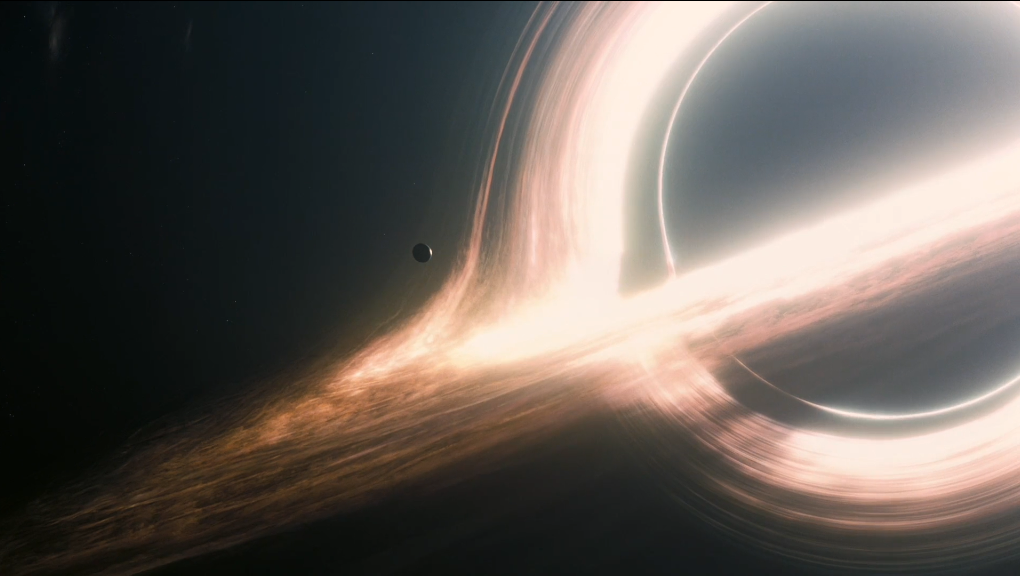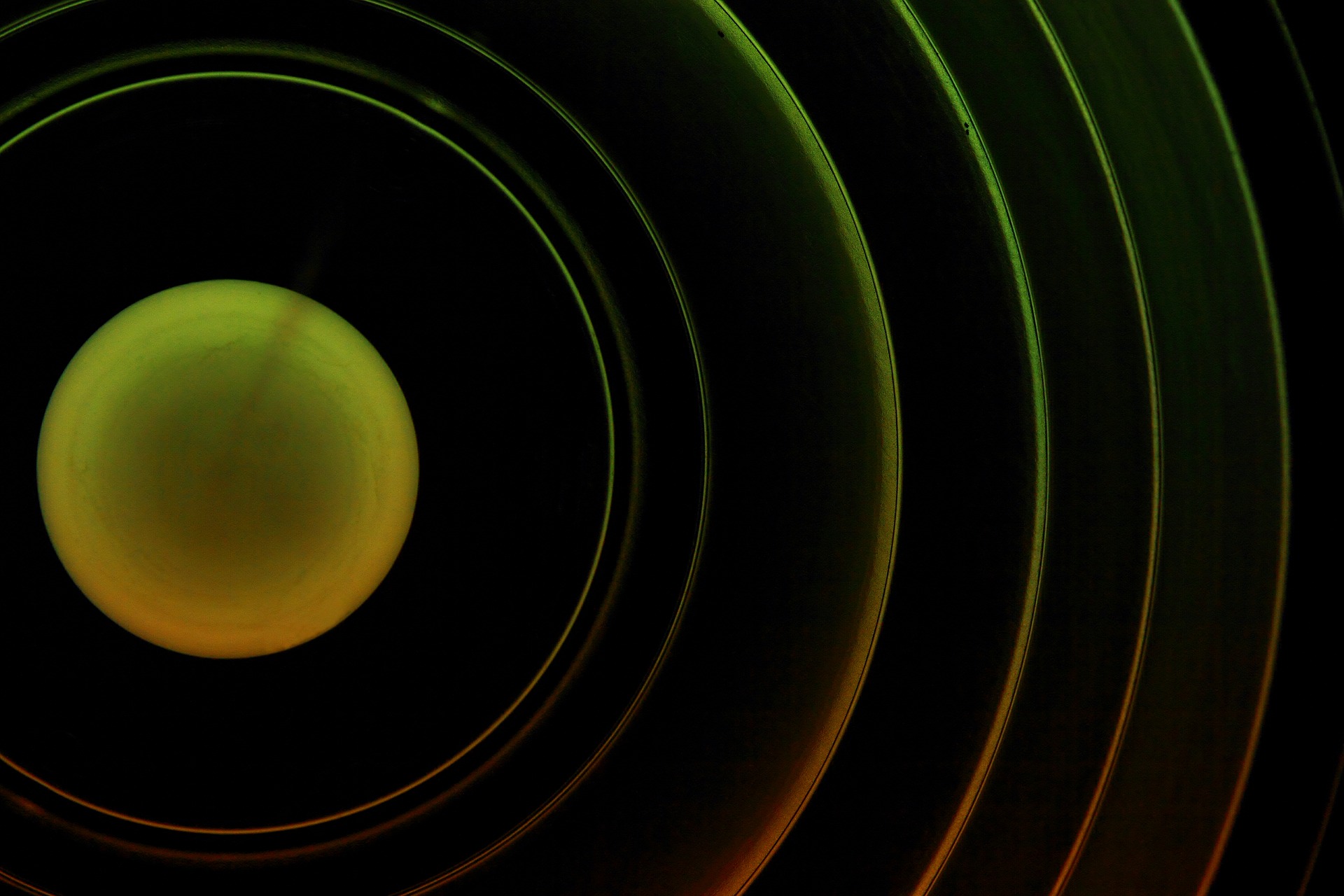
A simulated view of a black hole from the 2014 film ‘Interstellar’. Image: YouTube.
Of all the unsolved problems in physics, the black hole information paradox feels most like a whodunit. It’s a classic locked room mystery, and the victim in this case is quantum information.
Imagine a man goes inside a room and gets locked in. The police arrive at the scene and go in to find no trace of the man. Instead there are some bricks, a coffee machine and a dictionary (or any other set of random items) whose combined weight equals that of the man. Mass has been conserved – but without any trace of the man himself, no one can figure out his identity or how he vanished. This happens every time someone goes into one of these rooms: they disappear leaving behind a random set of items. The identity of the person is simply lost.
The black hole information loss paradox is a mystery along similarly bizarre lines.
A very fundamental law of physics says that quantum information can never disappear. But this is precisely what seems to happen in black holes. An inevitable consequence of several fundamental laws of physics is that heat must be released into space from near the black hole. This in turn should cause the black hole to shrink. As more heat is released, slowly, over time, the black hole will eventually disappear – leaving nothing behind but heat.
Whatever the black hole had swallowed would have carried its quantum information with it. However, there is no quantum information present in the heat.
Did quantum information really disappear? A fundamental law says it can’t. So could it have come out of the black hole? Again, several fundamental laws say that’s not possible either. So what is going on? Which of these laws is lying?
The case remains unsolved. We’ve learnt a lot from interrogating the laws but we haven’t ruled any of them out as suspects.
§

In 1915, Albert Einstein completed his theory of general relativity by writing down the equation that encapsulated the laws of gravitation – which we now call Einstein’s equation. In a few months, the German physicist Karl Schwarzschild found the first exact solution to Einstein’s equation, although it took physicists a couple decades to fully understand it.
Schwarzschild had found that Einstein’s theory appeared to allow for certain special regions in spacetime where something that entered the region once would never be able to escape back out – not even light.
A second curious feature of Schwarzschild’s solution was that, if you went closer and closer to the centre of a black hole, the black hole’s gravitational force would just keep getting stronger, and right at the centre become infinite. This point, called a singularity, is where the theories of relativity are expected to break down, and become utterly useless at predicting what happens there. Anything that falls inside a black hole is doomed to eventually reach the singularity.
The next big step in our understanding of black holes was taken in 1938, by a forgotten Indian physicist named B. Datt (and independently by J. Robert Oppenheimer and Hartland Snyder a year later). Datt (and Oppenheimer-Snyder) showed that black holes are not just theoretical possibilities – they could be quite real objects, as the products of naturally occurring processes, waiting to be discovered in outer space.
We know today that if we packed a certain amount of matter into a sufficiently small volume of space, it will inevitably lead to the formation of a black hole. This is just what happens when the core of a sufficiently massive star can no longer perform nuclear fusion, and implodes under its own weight to become a black hole. So the work of Datt (and Oppenheimer-Snyder) indicated that black holes must be out there, waiting to be found by our telescopes.
As of 2020, we’ve spotted hundreds; astrophysicists have even estimated there could be 10 million to a billion in just the Milky Way galaxy.
The 1950s and 1960s were called the golden age of general relativity: physicists made rapid strides in this area of physics at this time. For example, they found there are different types of black holes – ones that spin and ones that don’t, ones that carry electromagnetic charge and ones that don’t, with different combinations of these attributes.
It was around this time that physicists proved what came to be called the ‘no hair’ theorem. The ‘no hair’ theorem states if two black holes have the same mass, electromagnetic charge and angular momentum (the momentum of its spin), then their behaviour would be completely identical.
In other words, if you’re observing a black hole from the outside, and you’ve learnt these three pieces of information, there is no further detail you can hope to learn about a black hole. The theorem’s name alludes to bald pates: without hair, there isn’t much with which to tell them apart.
By extension, you can discern no information about anything that has fallen inside from the outside – except their contribution to the mass, charge and angular momentum of the black hole itself.
§

As our understanding of space, time and gravity grew in leaps and bounds in the first half of the 20th century, so did our understanding of matter. Broadly speaking, physicists learned quantum theory could describe the properties of all matter and their interactions – barring those mediated by gravity.
For our discussion, we need to bear two things about quantum theory in mind.
First, any physical object – an electron, a car, the moon, whatever – can be described by a mathematical state at any point of time. Quantum theory is a probabilistic theory – all its predictions are in terms of probabilities. It can’t tell us where exactly an electron will be found in an experiment but it can tell us what the probability of finding it in a given location will be.
The mathematical state contains the table of all such probabilities, and encodes all possible knowledge of the object. That is, the set of probabilities for all possible experiments that can be performed on the object at that time can be read from the state.
The knowledge of the state is called quantum information.
Second, if we know the state of an object at one point of time, we can predict what its state will be at a future point as well as figure out what its state was at any point in its history. This is a different way to say the knowledge of the state is never lost; it’s always encoded in the future state. Ergo, quantum information never disappears.
In the late 1960s and 1970s, physicists working on general relativity started incorporating quantum theory in their work. Of the many questions they were interested in, one was to ask what quantum theory predicts about black holes.
Stephen Hawking provided the first fully rigorous solution to this problem – but his findings surprised the community, including Hawking himself. Hawking had found (on paper) that radiation is released into space from the immediate vicinity of a black hole – not the black hole itself – in a process that causes the black hole to slowly lose energy and shrink. Eventually, the black hole disappears entirely, leaving behind just the radiation.
Also read: The Little Known Calcutta Scientist Whose Shoulders Hawking Stood On
This sounds innocuous – but the kicker is that the radiation is thermal, i.e. heat. By studying it and measuring it, physicists can only extract information about the black hole’s mass, electromagnetic charge and angular momentum at the time the heat was emitted – the three quantities the no-hair theorem says completely describe a black hole to anyone on the outside. This is to be expected: the radiation also comes from just outside of the black hole, so the most it can tell us will have to do with these three properties.
Thermal radiation is purely random, and can’t encode any information.
However, the laws of quantum theory should allow us to deduce an object’s state in the past based on its state in the present. But for black holes the final state appears to be just wisps of heat with information about nothing but mass, charge and angular momentum. Quantum information went in and all that came out was randomness.
This is the black hole information loss paradox.
§

Since Hawking first hit upon the solution in his calculations, physicists have derived and re-derived his result in different ways, always to the same conclusion. The paradox follows straightforwardly from the same fundamental principles that hold in all other known physical situations, without causing any other paradoxes.
Scientists have proposed different competing ways to resolve the paradox. Most of them pin the blame on one of the fundamental principles and ask physicists to sacrifice it. Some others hold that hitherto unknown laws of physics could come to the rescue and eliminate the paradox.
A proposal called the remnant scenario is of the latter type. When gravitational forces are very strong, for example close to the singularity at the centre of a black hole, the laws of general relativity start breaking down. In these situations, we expect a deeper theory to take over – a theory of quantum gravity. We still don’t know what the correct theory of quantum gravity is – string theory is a leading candidate – but we know it has to exist.
In the late stages of its evaporation, a black hole becomes so small that the rules of quantum gravity must take over. Physicists have hypothesised that the rules of quantum gravity could predict that the evaporation stops when the black hole is small, leaving behind a tiny black hole called the remnant. Then there is no paradox: the remnant will still contain the objects the erstwhile black hole swallowed, and their states will continue to encode information about their past and future.
Sure, we can’t access these objects or their information from the outside, but this limitation doesn’t contradict quantum theory.
Another version of the remnant scenario hypothesises that once the laws of quantum gravity take over, the Hawking radiation will no longer be thermal and that radiation encoding all the missing information will be released at once into spacetime.
One objection to the remnant scenario is that the remnant might be too small to contain so much information. Supporters of the scenario have in turn pointed out that there are some convoluted geometrical structures that look small from the outside but have enough volume to contain the information. But we don’t know if such solutions would be stable from quantum theory’s perspective, and of course we don’t know what the rules of quantum gravity will actually say.
Another idea is that the radiation coming from near black holes is only approximately thermal, that there are subtle deviations from randomness that encode the quantum information of all objects that fell in. In this scenario, the seemingly lost quantum information comes out with the radiation.
This idea differs from the remnant scenario in that the radiation is assumed to be non-thermal right from the start, as opposed in very late stages of the black hole’s evaporation. But there’s a problem: the no-hair theorem restricts the amount of information we can have about the black hole that presents on the outside, so how can the radiation coming from just outside the black hole know more about it?
So it must be that the radiation somehow knows about the inside, even though not even light could have escaped from the inside. This is forbidden in physics by the principle of locality, which says information can’t be transmitted between two points unless light – or any other physical signal – can travel from one to the other. Which means this idea can pan out only if we discard the principle of locality.
Also read: A 200-Year-Old Experiment Has Helped Us See a Black Hole’s Shadow
A third idea holds that black holes are very different from what general relativity tells us. According to string theory, for example, as black holes shrink, they’ll be replaced by more complicated quantum objects called fuzzballs. And unlike black holes, fuzzballs have plenty of hair, so the radiation coming from their vicinity will no longer be short on information.
If you looked at a fuzzball from a distance, you wouldn’t be able to tell it apart from a conventional black hole. But if you got really, really close, they’d look very different. Near the surface of a big-enough black hole, gravity is really weak – and the fuzzball idea proposes that general relativity is modified even in this situation. A cherished belief among physicists – true in all known cases – is that unknown physics only comes into play when really high energies are involved, like in the remnant scenario. Modifying general relativity at low energies like the fuzzball idea requires us to ditch this principle.
There’s yet another possibility, but it’s not popular: that the law of conservation of quantum information is simply incorrect, that quantum information can disappear, and that’s that.
We have made great advances in physics in the last 120 years or so, propelled by the twin revolutions of general relativity and quantum theory. Between them, these two theories can explain everything from the behaviour of subatomic particles to collisions of black holes billions of years ago.
However, the interplay of these two theories gives us the black hole information loss paradox. Physicists have learned a lot about the universe and conceived many fascinating ideas through attempts to resolve it. But the paradox itself remains mystifying, out of reach of explanation. Then again, what’s a good whodunit if it doesn’t make you work hard to solve the mystery?
The reveal – whenever one comes – will not only teach us something deep about nature, it also promises to be great fun. 😈
Nirmalya Kajuri is a theoretical physicist. He is currently a postdoctoral fellow in the Chennai Mathematical Institute.

